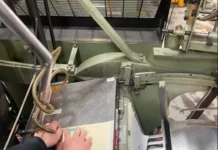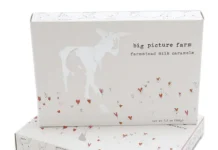By Sabine Lenz, PaperSpecs
Each year, a handful of printing and finishing techniques set the industry on fire, transforming the way designers create their work, spread their message and even the way they think. If you’re looking for a way to help your clients jumpstart their creativity while giving you a competitive edge, you really can’t afford to dismiss them.
1. Sustainability
In 2020, when many of us got to spend more time outdoors, enjoying the clean air, positive environmental change started to feel a little more doable. Increasingly, consumers are becoming more mindful of how they can help achieve this.
For any print project, this means:
Reduce. The most effective way to reduce waste is to not create it in the first place.
Right-size. This is not only important to the final cost of the product, but also to its perceived environmental impact.
Print on demand. Ask yourself “What is the quantity my customer needs right now,” and “What is the longevity of the piece?” Thanks to digital printing and finishing, there really is no need to overproduce.
Reduce overall waste. Here is your chance to help creatives understand how to best utilize a press sheet. They’re eager to be more sustainable and open to your advice.
Reuse. Help your customers explore ways in which they might be able to repurpose their packaging and materials – and yes, this includes die-lines and other tools.
Recycle. From recycled papers to substrates made with agri-waste (hemp, wheat) and recycled jeans, T-shirts and even coffee cups, there is no shortage of innovative new materials. Be the one to bring these exciting options to your clients; they will appreciate your forward, sustainable thinking.
2. Gold Metallic Designs
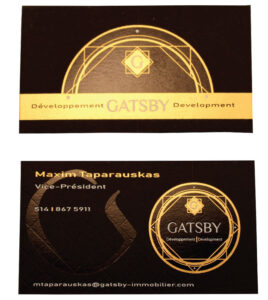 Metallic effects in design are becoming uber-trendy. Already ubiquitous in product design, gold especially is popular. From packaging to business cards, gold gives any printed item a luxurious, expensive feel.
Metallic effects in design are becoming uber-trendy. Already ubiquitous in product design, gold especially is popular. From packaging to business cards, gold gives any printed item a luxurious, expensive feel.
Granted, the shimmer that foil brings has been on trend for a while now, but beyond foil stamping, several newer technologies have become more widely available, offering creatives new possibilities and creating a resurgence of shimmer and gold.
From hot and cold foil to foil substrates and digital foiling options, there is a foil – or better said, gold foil – option for every print run and budget.
3. Swiss Binding
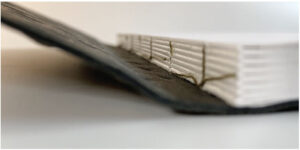 In the last few years, exposed (or naked) spines – books and booklets that proudly show off the thread that holds them together – have increased in popularity. Using contrasting or complementing thread colors, designers are reveling in these new-found binding embellishments.
In the last few years, exposed (or naked) spines – books and booklets that proudly show off the thread that holds them together – have increased in popularity. Using contrasting or complementing thread colors, designers are reveling in these new-found binding embellishments.
Traditionally once trends reach their peak, they either fade out or someone adds a new twist. And today’s new twist is Swiss binding.
Instead of being inserted and mounted in casebound fashion, in Swiss binding the text block is glued right on top of the inside back cover of the book’s case. While from the outside the book looks like a nice casebound book, once the cover is opened, the text block’s spine is revealed. In most cases the text block is Smyth bound, yet feel free to use perfect bound or saddlestitched text blocks, too.
4. Bright Colors
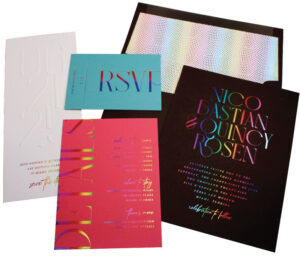 While bold colors have been trending in the online world for a while now, thanks to enhanced print technology, we can go bold, loud and brighter than ever before in print.
While bold colors have been trending in the online world for a while now, thanks to enhanced print technology, we can go bold, loud and brighter than ever before in print.
All this is thanks to neon inks used with traditional printing techniques – offset, letterpress and silk screen – but also in digital printing. This includes neon yellow, pink, orange, violet and green.
Encourage your customers to crank up their design’s “look at me” factor by using vibrant neon colors as spot colors.
You also can use them to extend the overall color gamut. When we are talking 5+ color printing, we are adding more colors to a conventional 4-color process setup.
This is popular for two reasons:
- To increase the overall range of colors, creating really rich hues
- The extra colors can be used to reproduce a special hue that is out of range of the standard CMYK mix, meaning you can match about 99% of Pantone colors on a digital press.
5. Haptic
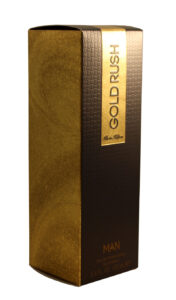 In this over-digitalized world, people yearn for a tactile experience. Tactile effects on marketing materials – but especially packaging – have been becoming increasingly popular.
In this over-digitalized world, people yearn for a tactile experience. Tactile effects on marketing materials – but especially packaging – have been becoming increasingly popular.
There are two ways to enhance a project’s haptic appeal:
- Substrate. From classic linen and felt textures to more daring ones like wood grain, using a textured substrate is probably the easiest way to bring a tactile aspect to any printed piece.
- Finishing. From traditional embossing to profile-raising spot UV (using either screen UV coatings or newer digital finishing), there is no shortage of ways for you to help your customers add that extra tactile feel. Soft-touch laminates and coatings continue to be very popular, while other specialty coatings, including sandpaper and leather textures, provide intriguing options as well. New digital options for applying spot UV coatings have opened up many opportunities for adding texture to packaging, direct mail and other printed materials.
6. Customization and Personalization
A recent McKinsey study found that personalization will be the prime driver of marketing success within five years.
Nobody wants to be bothered by irrelevant coupons, emails or texts, but they do want to be informed of offers that meet their needs.
Personalization offers meaningful, relevant customer communication. While the technology for this (e.g., variable data printing) has been around for a while, few brands are fully embracing it. Successful brands need to focus on good customer data, insightful analytics and, above all, ensuring that they protect customer privacy.
Customization. Thanks to processing code (a scripting language that can create graphic elements) or tools like SmartStream, the ability to create unique covers, packaging and bottle designs is at our fingertips. Best of all, your clients don’t have to be a global powerhouse to benefit from these trends.
7. Augmented Reality (AR)
As you know, AR enhances the user’s perception of the real world by adding a computer-simulated layer of information on top of it. In print, one of the most used interactions is when the activation is triggered by scanning a specific item, or “marker.”
But trying to convince customers to download an app can be tricky, let alone providing an app that’s compatible with all the different types of phone and operating systems out there.
That’s why marketers have started looking seriously into WebAR. It may not have the power of full AR but it still has plenty of potential.
WebAR refers to augmented reality experiences that are accessed through a web browser rather than an app. This means all you need is your smartphone or tablet and an internet connection – no apps required.
With the introduction of ARKit and ARCore (the Apple and Google AR developer platforms) and web-based AR platforms such as 8th Wall, marketers now have a big opportunity to create innovative campaigns that integrate the digital and physical worlds.
Whether it’s through augmenting product packaging with interactive content, virtual tours in brick-and-mortar shops or “try before you buy” at home opportunities (Starbucks or IKEA are two obvious examples), augmented reality is enriching the customer experience digitally in a way that few technologies can.
These are the seven top print design trends, but are they all for you or your clients? Probably not. But mix and match two or more of these trends and you will delight your customers with the opportunities you can provide.
PaperSpecs.com is an innovative online hub for brand owners and graphic designers who actively spec paper and print, and refuse to be limited by short print runs or tight budgets.
Through videos, hands-on/virtual “Live [unboxed]” events, blog posts and more, PaperSpecs provides trends, insights and access to crucial, hands-on tools and resources to help creatives craft printed pieces that WOW their clients. Don’t miss the weekly tips, trends and insights: www.paperspecs.com/get-weekly-tips/



